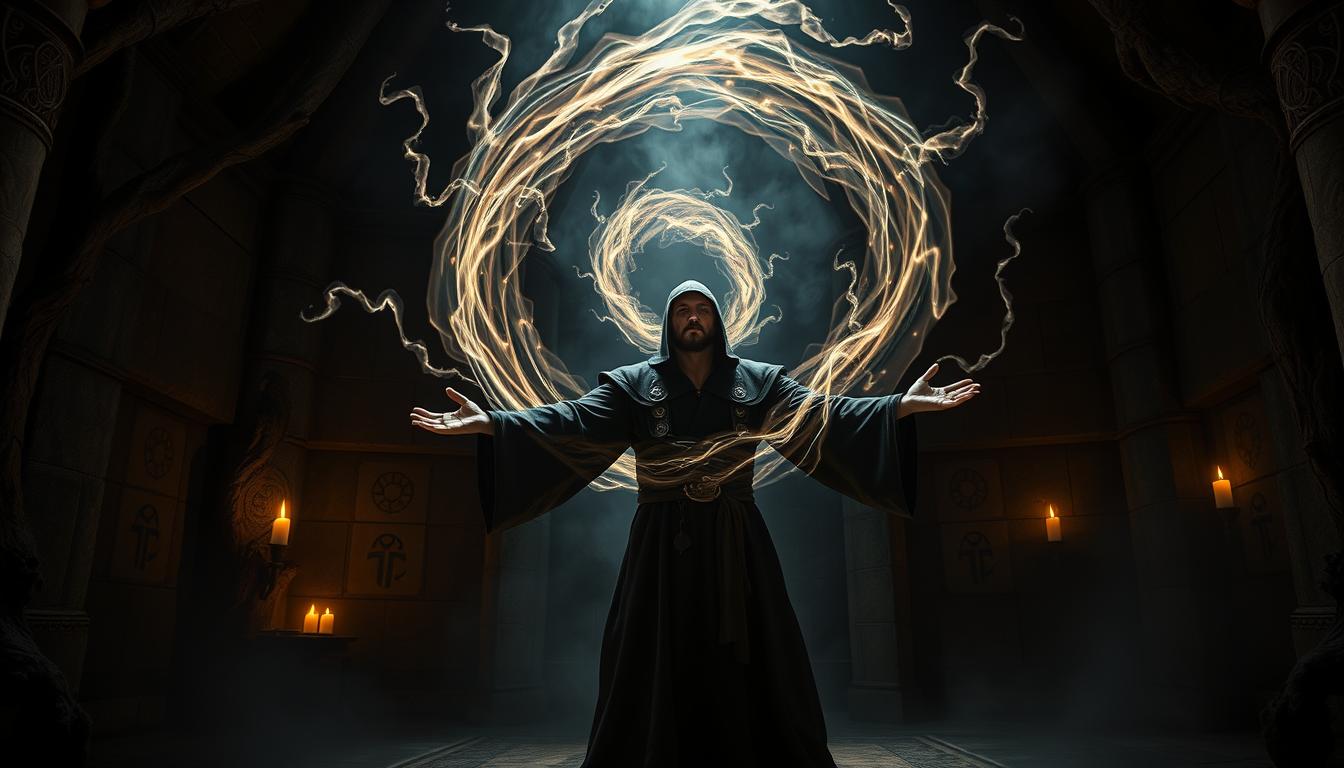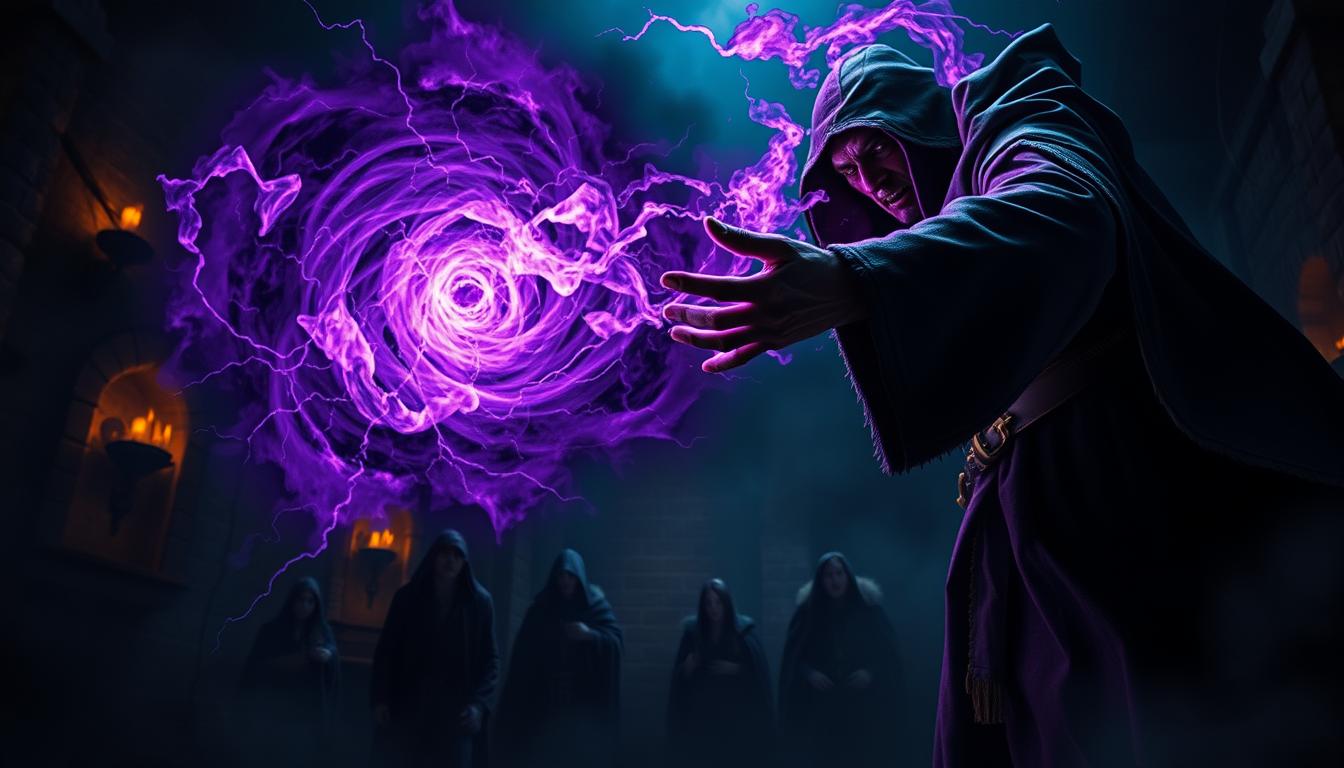Discover the Secrets of the Fear Spell 5e
Ever wondered how to turn the tide of battle with a single move? Imagine forcing your enemies to drop their weapons and flee in terror—no brute force needed. That’s the power of a well-placed illusion spell in Dungeons & Dragons 5th Edition.

This game-changing ability doesn’t just scatter foes—it reshapes the battlefield. With a flick of your wrist, you can clear tight dungeon corridors or buy precious time for your party. The best part? It lasts just long enough to shift the odds in your favor.
I’ve spent years mastering this crowd-control powerhouse, and I’m ready to share the tricks that make it unstoppable. Whether you’re a seasoned caster or a curious newcomer, these insights will level up your strategy.
Key Takeaways
- Transforms battles by forcing enemies to flee and drop items
- Perfect for tight spaces with its 30-foot cone effect
- Lasts up to 1 minute with careful concentration
- Works best against multiple weaker creatures
- Combines well with terrain advantages
What Is the Fear Spell 5e?
Picture this: enemies scrambling in panic, weapons clattering to the ground as they flee from unseen horrors. That’s the raw power of this illusion-based ability. It doesn’t just scare foes—it reshapes entire encounters with a single action.
Spell Overview and Effects
When cast, this magic conjures phantasmal images of each creature’s worst fears within a 30-foot cone. Targets must succeed on a Wisdom saving throw or face two devastating effects:
- Immediately drop whatever they’re holding
- Gain the frightened condition for up to 1 minute
The area-of-effect design makes it perfect for crowd control. Unlike single-target abilities, it pressures multiple enemies simultaneously. I’ve seen entire archer squads rendered useless when their bows hit the dirt.
| Effect | Game Impact |
|---|---|
| Dropped items | Disarms melee fighters and stops spellcasting |
| Frightened condition | Forces movement away and gives disadvantage |
| 30-foot cone | Hits groups without harming allies |
Who Can Cast It?
This potent magic isn’t for every class. Currently, five archetypes can wield it:
- Bards (Level 3)
- Sorcerers (Level 3)
- Warlocks (Level 3)
- Wizards (Level 3)
- Occultists (Homebrew)
The material components—a white feather or hen’s heart—add eerie flavor. These items symbolize vulnerability, perfectly matching the magic’s nature. Keep them handy in your component pouch.
What makes this ability stand out? Unlike simple damage spells, it creates tactical opportunities. When enemies flee, you control the battlefield. When they drop weapons, you remove threats without landing a single blow.
How to Cast the Fear Spell 5e
Timing and precision turn this illusion into a battlefield game-changer. To wield it effectively, you’ll need to master its casting mechanics, positioning, and focus. Here’s how to make every cast count.

Casting Time and Components
The 1-action casting time lets you disrupt enemies instantly. You’ll need three components:
- Verbal: A chilling incantation
- Somatic: A sharp gesture
- Material: A white feather or hen’s heart
I always keep extras in my pouch—losing focus mid-combat wastes precious turns.
Targeting and Area of Effect
This magic originates from you, blasting forward in a 30-foot cone. Aim it like a spotlight:
- Position yourself to catch multiple creatures
- Avoid allies in the cone’s path
- Use walls to funnel fleeing enemies
In tight dungeons, I angle it diagonally to maximize coverage.
Concentration and Duration
Maintaining concentration for the full minute is tricky. Three tips help:
- Distance: Stay 60+ feet from melee threats
- Cover: Use pillars or allies as shields
- Backup: Have a teammate ready to intercept
Most players forget to track duration—set a die at “10” and decrement each round.
Understanding the Fear Spell Mechanics
Wisdom saves and forced movement create opportunities most players miss. Behind every panicked flee lies a web of rules that can make or break your strategy. Let’s crack open the mechanics like a DM’s guide.
Saving Throws and Frightened Condition
Targets roll a Wisdom saving throw when the magic hits—and again if they break line of sight. The DC? Your spellcasting ability + 8. I’ve seen parties stack debuffs to cripple enemy saves.
- Instant disarm: Weapons and foci hit the ground
- Frightened: Disadvantage on attacks/checks while you’re visible
Line of Sight and Spell Termination
Smart enemies duck behind cover. Breaking line of sight grants another save—but here’s the twist. The spell ends for that creature on a successful save. Use terrain to your advantage:
- Corner peaks force enemies to choose: flee or face you
- Fog clouds block vision but don’t stop the effect
Movement and Dash Action Rules
Frightened foes must take the dash action away using the safest route. This triggers opportunity attacks—unless they’re cunning. I once saw a goblin intentionally provoke one to escape a cliff edge.
| Movement Trick | Outcome |
|---|---|
| Herding toward hazards | Free damage from pits/lava |
| Readied actions | Allies strike as enemies pass |
Tactical Uses of the Fear Spell 5e
Nothing reshapes combat faster than forcing foes to abandon their positions. This magic turns enemies into unwilling chess pieces—if you know how to play the board. I’ve used it to collapse flanking maneuvers and create perfect ambush zones.

Best Scenarios to Cast
Three situations make this ability devastating:
- Choke points: Funnel creatures through doorways where allies wait
- Elevation advantage: Force enemies off cliffs or into hazards
- Weapon-dependent foes: Disarm warriors before they strike
Last session, I angled the 30-foot cone across a bridge. The orcs had to take dash action backward—right into our rogue’s trap.
Combining with Other Spells
Pair this with area control for brutal results:
- Cast Wall of Fire behind fleeing creatures
- Drop Spike Growth along their escape path
- Use Grease where they’ll drop weapons
Remember: creatures must move away using the safest available route. That “safety” can be an illusion.
Avoiding Friendly Fire
The cone doesn’t discriminate. Two positioning tricks save allies:
- Flank formation: Keep teammates at 45-degree angles
- Delayed engagement: Have melee fighters charge after casting
I once saw a paladin lose his holy avenger to this. Now we call positions before combat starts.
Conclusion
Few abilities shift combat momentum as dramatically as this one. The Fear Spell 5e outshines similar options by forcing disarmament and movement—no other crowd-control tool offers both.
Time it right: cast early in initiative to wreck enemy formations. Pair it with hazards or readied attacks for maximum chaos.
DMs, take note. If players abuse this, mix in foes with successful save odds or ranged attackers. Balance keeps battles thrilling.
I’ve seen this spell turn hopeless fights into victories. Try it next session—you’ll never underestimate a frightened creature again.